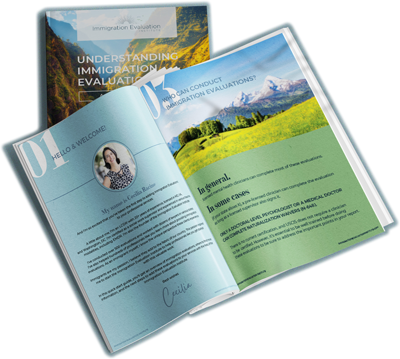What do you want to learn more about?

October is Domestic Violence Awareness Month and I wanted to discuss some of the ways that domestic violence can affect immigrants in particular. Immigrants who suffer domestic violence often face unique challenges in seeking support, and their abusers possess additional avenues through which to exert their control.
As immigration evaluation therapists, we may be asked to provide assessments for immigrants who are seeking changes to their immigration status on the basis of violence experienced in the home. Therefore, it is essential to understand the different forms of domestic violence.
In this blog post, we’ll outline a definition of domestic violence, address the unique challenges faced by immigrant populations experiencing domestic violence, and detail the forms of immigration relief a victim of domestic violence can apply for.
What is Domestic Violence?
Domestic violence is a catch-all term for violent acts that occur between two people in a close relationship, usually who live together. It can involve inflicting physical pain, intentionally impairing a physical condition, sexual assault, or threats of any of the above.
Importantly, the term ‘domestic violence’ is often used interchangeably with the terms ‘domestic abuse’ and ‘intimate partner violence,’ but all ultimately refer to similar patterns of behavior.
Domestic Violence Among Immigrant Populations
Domestic violence can often be accompanied by a wide range of abusive behaviors (National Center on Domestic and Sexual Violence, n.d.) that are not necessarily physical or sexual. Some of these are specific and unique to immigrant populations (Volpp & Marin, 1996).
Emotional Abuse
For example, if the abuser lied to the victim about their immigration status or called the victim racist names.
Economic Abuse
For example, forcing a victim to work illegally or sign legal documents in a language they do not understand.
Sexual Abuse
For example, misrepresenting the law in the country of residence to coerce the victim into having sex with the abuser whenever they want, or calling the victim a ‘mail-order bride.’
Coercion and Threats
For example, threatening to report the victim to government officials to get them deported, or threatening to harm, or harass someone in the victim’s family.
Manipulation Regarding Children
For example, convincing the victim that they will lose custody of children if they report the abuser, or threatening to remove a victim’s children from the United States.
Manipulation Regarding Citizenship or Residency
For example, withdrawing or not filing papers to legalize a victim’s residency status, or convincing the victim that they will be arrested due to their undocumented status if they contact the police.
Intimidation
For example, destroying legal documents, or threatening to reveal family secrets.
Isolation
For example, preventing the victim from learning English or controlling the time they may spend outside the home
Minimizing, Denying, and Blaming
For example, using gender as a justification for forms of abuse or claiming the victim will be responsible for the break-up of the family if they seek help.
Immigration Relief — the Violence Against Women Act (VAWA)
An immigrant client (of any gender) married to a US citizen or Lawful Permanent Resident, who has suffered domestic abuse may be eligible for immigration relief under the VAWA. By doing so, they self-petition for lawful status in the United States, separate from the perpetrator of the abuse.
If successful in their application, the victim will receive employment authorization, access public benefits, and become eligible to apply for lawful permanent residency status. It can also protect non-citizen victims of domestic abuse from being deported by canceling ongoing removal proceedings and granting the victim legal permanent residency status.
Closing Thoughts
As immigration evaluation therapists, we can do much to help victims of domestic violence overcome trauma and escape their abusers. Being aware of the various forms of domestic violence and abuse will help you to prepare robust evaluations that accurately represent the experiences of victims and support them in their cases.
If you’d like to learn more about the VAWA, please visit the American Immigration Council website. Other great resources on domestic violence include those available via the National Domestic Violence Hotline and the National Center on Domestic and Sexual Violence’s Power and Control Wheel.
References
American Immigration Council. (2019). Violence against women act (VAWA) provides protections for non-citizen women and victims of crime [Fact sheet].
National Center on Domestic and Sexual Violence. (n.d.). Power and Control Wheel.
Robert Wood Johnson Foundation. (2009). Intimate partner violence in immigrant and refugee communities: Challenges, promising practices, and recommendations.
Volpp, L., & Marin, L. (1996). Working with battered immigrant women: A handbook to make services accessible. San Francisco, CA: Family Violence Prevention Fund.

I’m Cecilia Racine, and I teach therapists how to help immigrants through my online courses. As a bilingual immigrant myself, I know the unique perspective that these clients are experiencing. I’ve conducted over 500 evaluations and work with dozens of lawyers in various states. Immigrants are my passion, I believe they add to the fabric of our country.
related articles
Helping Immigrants Find Safety and Healing Through U and T Visas
As mental health clinicians, we possess a unique set of skills that can be a…
Expand Your Expertise: Recommended Trainings for Immigration Clinicians
The Immigration Evaluation Institute Comprehensive course is a great first step into the world of…
Ethical Considerations in Immigration Evaluations
The role of mental health professionals in immigration evaluations is fraught with unique ethical complexities.…
Join the Free
Immigration evaluation
therapists facebook group
Are you a therapist that conducts immigration evaluations?



